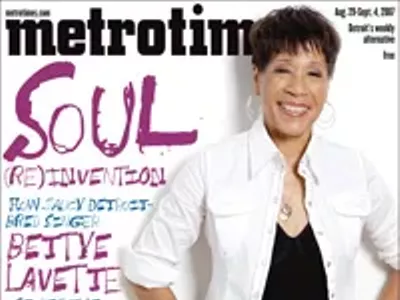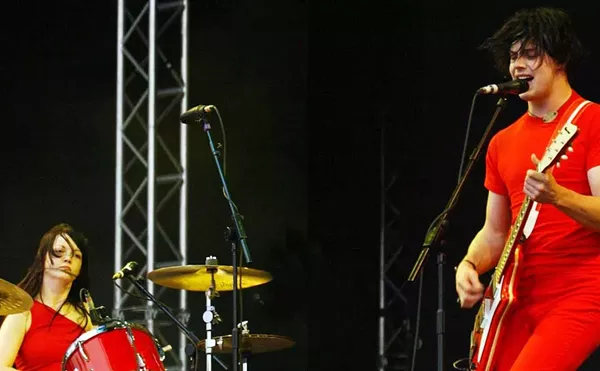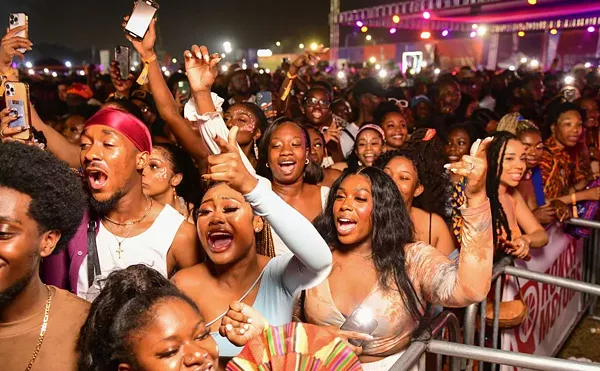
Audio By Carbonatix
[
{
"name": "GPT - Leaderboard - Inline - Content",
"component": "35519556",
"insertPoint": "5th",
"startingPoint": "3",
"requiredCountToDisplay": "3",
"maxInsertions": 100,
"adList": [
{
"adPreset": "LeaderboardInline"
}
]
}
]
As a neophyte of the '60s folk scene, Muldaur (then Maria D'Amato) first stepped in front of a recording microphone in 1964, as a member of the Even Dozen Jug Band. She was charged with singing Bessie Smith's carnal "Empty Bed Blues." After a dismal first take, producer Paul Rothchild (later better known for producing the Doors and Janis Joplin) dismissed the band and gave her a dressing down. Muldaur still cringes, 43 years later, at what her inexperience elicited from the producer. "He said something so politically incorrect to me that I was in shock," she confesses. "It was a long time before I even tried to sing one of those songs again!"
The Even Dozen disbanded after one album, and Maria joined the Jim Kweskin Jug Band, a mainstay of the Boston-Cambridge folk hub. The band, an odd assortment of specialists and virtuosos, had a far-flung repertoire, including songs by black jug bands, early Tin Pan Alley novelties and country breakdowns. Maria then married the brilliant guitarist and singer Geoff Muldaur, the resident Kweskin blues scholar. He recognized her timbral similarity to swing singer Mildred Bailey, and Maria's featured numbers became wide and varied. "I've sung every kind of American roots music you can name," she notes.
In 1965, she recorded "I'm a Woman," Jerry Leiber and Mike Stoller's proto-feminist anthem, originally written for Peggy Lee. But whereas Lee sang the song with Nordic iciness, Maria's earthiness conjured a "can-do woman" with a child on the hip, a frying pan in hand, a smile on her man's face, and the world by the tail. "When we heard the record," Stoller recently told Metro Times, "we liked it very much. It wasn't anything like Peggy but it was marvelous. But I really got to know Maria's music better after she did Midnight at the Oasis. That's one of the best albums of any era — for the songs, the band and, of course, the singer."
Jump to the present and Maria's new work with a Detroit staple. Before he became a renowned lighting designer (with 22 patents to his name) via his Farmington Hills-based Illuminating Concepts, Ron Harwood was a blues enthusiast from Mumford High. In 1965, Harwood located the legendary blues singer Sippie Wallace — who had recorded deliciously risqué songs during the blues' heyday — in Detroit and coaxed her out of retirement. He then engaged the Kweskin band (including the Muldaurs), who he'd come to know at the Chess Mate coffeehouse, to back Sippie during a recording session. The sessions followed a concert Wallace did with the band, also via Harwood's instigation, at New York City's Town Hall in 1966. Every label passed on it at the time, but the album was finally released in 1994 as Mighty Tight Woman on the Drive Archive label.
Things came full circle when Harwood agreed to produce Naughty, Bawdy & Blue for Muldaur. "I've known Maria for years, of course," he says, "but this album grew out of a concert I produced as part of the Motor City Blues & Boogie Festival in 2003 featuring Maria and Jim Dapogny's Chicago Jazz Band. [The concert was recorded and turned into the national PBS documentary, Boogie & the Blues Diva.] It was a great match of singer and band. So, when the idea of this album came up, Jim wrote some charts and we did a run-through in the studio. As soon as we heard the first tune, it was goose bumps. We knew we were onto something."
The album was eventually recorded at Ann Arbor's Solid Sound Studios, the same studio where Wallace and the Dapogny Band recorded the Grammy-nominated Sippie with Wallace in 1982.
Interestingly, due to her earlier involvement with the blues diva, Muldaur had gotten close to both Wallace and her Brooklyn contemporary, Victoria Spivey, in the years before their deaths. "Sippie," explains Maria, "was very warm and very sweet. But Victoria was a sassy one. She didn't take crap from anybody. She was the first artist I knew of to have her own record label. And she was smart — she was the first artist to cover Bob Dylan."
In her jug band days, Muldaur was patronized by the people around her and often told to steer clear of the classic blues repertoire. She recalls: "They used to say, 'Maria, why don't you just stick to light jazz?' Now, I can deliver those songs with total authority. They're full of real life experiences and you have to live some before you understand them fully."
Harwood concurs. "She didn't want to be Sippie Wallace on these tracks, but she didn't have to be," he says. "She's Maria Muldaur. She's really good at letting you think you're smarter than she is. Then she'll let you know that you're not. Both she and [ex-husband] Geoff always understood the blues and could interpret it."
Continues Maria: "The classic blues women were liberated long before anyone used the term 'women's lib.' They were their own women. They got around the social constraints and limitations of the era, when black and white women were pretty much supplicated to male supremacy. They rose above it and used a very unabashed self-expression — it was bawdy but still ladylike. These women lived life the way they pleased."
Indeed, the women who originally sang classic blues on vaudeville stages were the black queens of show business. They performed, dressed and lived extravagantly, with whole companies of performers often touring alongside them. The flamboyance in their songs was matched by the lifestyles of these divas. They dressed in expensive gowns and often traveled in private train cars. Buffet flats — houses that served as, um, sexual smorgasbords — were just part of the experience.
So, how does Muldaur see the work she and Harwood have done in relation to contemporary standards? "I hear these young women," she says, with audible exasperation, "these singer-songwriters — and there's so much hand-wringing and emotional anxiety in their songs that I could just stab myself! It's all about their fragile little feelings; I call it 'Dear Diary music.' I know it's popular right now but I don't have to listen to it."
At 3:30 p.m. Monday, Sept. 3, on the Carhartt Amphitheatre Stage as part of the Detroit International Jazz Festival.
Ron Harwood's 9th Annual Motor City Blues & Boogie Woogie Festival will take place in downtown Detroit at the Music Hall Center for the Performing Arts on Friday and Saturday, Oct. 5 and 6, with Koko Taylor and Marcia Ball headlining. The performances will be recorded for public television.
Kirk Silsbee is a freelance writer. Send comments to letters@metrotimes.com





